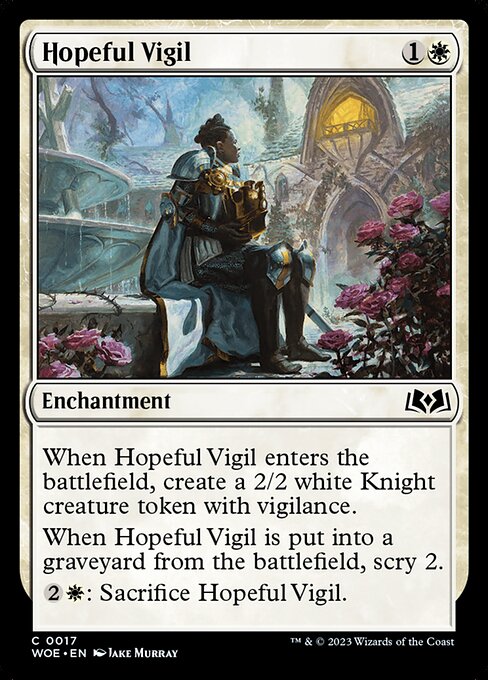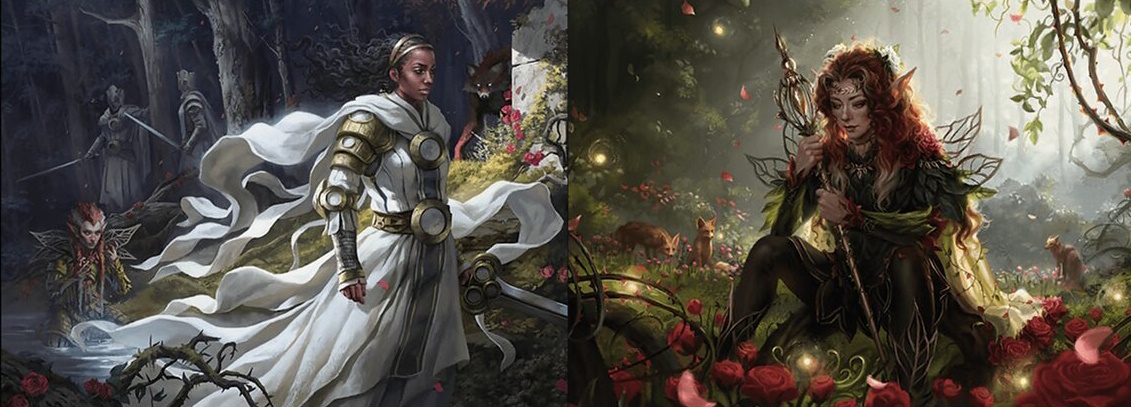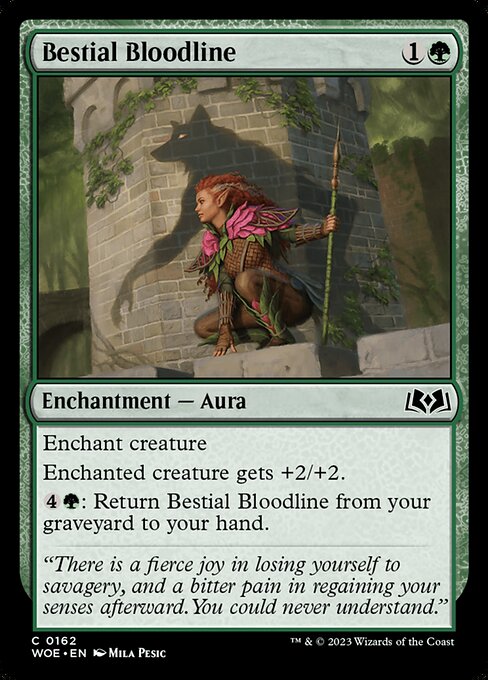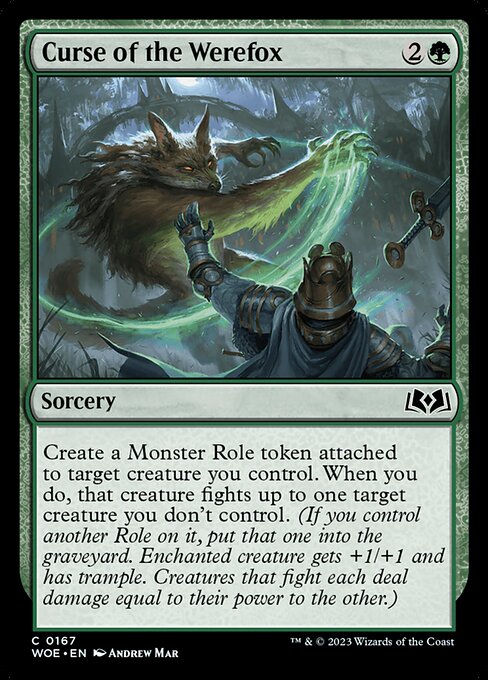Wizards recently (finally) published an article laying out the specific fairy tales being retold in Wilds of Eldraine (apparently enough people complained to Mark Rosewater about the lack of supporting lore information–a “Legends Of” article or side stories, for instance–that he decided to do it himself). He confirmed that Beauty and the Beast is, as alert Vorthoi have long known, the main story being retold in Green/White, and today I want to zoom in on the version of that story presented in the cards of Wilds of Eldraine a little bit (ok, a lot). There’s no use denying that one major reason I chose this story is that it’s a queer retelling, but I’m not just indulging myself: I do think it’s also a pretty interesting case study in how Wizards updated traditional fairy tales for this set, and also at how Wizards tells a story purely through cards. So, let’s dive in.

The essential beats of Beauty and the Beast are probably familiar to almost every reader, but for the record: a virtuous, beautiful woman becomes trapped in a castle with a monster, but slowly realizes he’s more humane than she first suspected. In fact, he’s kind enough that he eventually lets her go. But she realizes she’s grown to love him, and returns to help him in a time of need. He turns into a handsome prince, revealing that he was cursed to live as a beast until he found someone who could love him in that form. And they all live happily, etc.
The details of the story do, of course, change significantly in each retelling. The oldest extant version (authored by Gabrielle-Suzanne de Villeneuve in 1740, although oral versions were likely widespread before that) has Beauty as one of many siblings, no rival suitor character, and no servants of the Beast transformed into inanimate objects, all pretty big differences from the Disney version that’s best known today. The Wilds of Eldraine telling is, as you would expect, a significant departure from either version.
Syr Armont, the Redeemer, a famous knight in Eldraine, is our Beauty (and a signpost uncommon). She comes, with some other former knights of the ruined court of Ardenvale, to a castle called Redtooth Keep. By day she is hosted by Yenna, Redtooth Regent and her refined elven courtiers. At night, she and her companions are harried by monstrous werefoxes. It doesn’t take Armont long to realize that the Redtooth elves and the werefoxes are one and the same. “Both bloom and thorn,” as Yenna puts it, in the flavor text of her card.

Syr Armont, the Redeemer by Magali Villeneuve and Yenna, Redtooth Regent by Justyna Dura
There are a number of cards that fill in details of the world and the people around Armont and Yenna. The elven courtiers have a scholarly refinement at odds with their bestial nature (Redtooth Genealogist, Elvish Archivist. Ferocious Werefox shows one of them caught in the horrible moment of transformation. The knights exist in uneasy tension with the werefoxes, sometimes endangered by them (Curse of the Werefox, sometimes fighting alongside them (Werefox Bodyguard). At least one Besotted Knight other than Armont falls in love with a werefox.
But fairy tales ultimately hinge on the decisions and emotions of the principal characters. This particular storyline uses flavor text very well, not just to exposit, but to get inside of Armont and Yenna’s heads. Parallel Lives portrays the duality of the Redtooth elves, and the flavor text tells us that Armont has trouble trusting her monstrous hosts. “Was the elves’ true nature that of day’s civility or night’s savagery? Could such bestial rage be bestowed by curse alone?” she muses. The flavor text on Bestial Bloodline shows that Yenna has similar questions about her own nature: “There is a fierce joy in losing yourself to savagery, and a bitter pain in regaining your senses afterward,” a Redtooth declares (presumably Yenna, and presumably to Armont). And then she adds: “You could never understand.” Perhaps Yenna isn’t sure that she wants the curse lifted–and perhaps (this is more of a leap) she worries that means she really is a monster. In any event, she doesn’t want the help of some perfect knight.

These doubts and ruminations get, to me, to the heart of the Beauty and the Beast story. Beauty’s decision to leave Beast’s castle, and the Beast’s decision to let her, are a difficult passage of doubt that they both need to move through in order to be together, resolved when Beauty realizes he’s in danger and hurries back to help. In the Wilds of Eldraine version, it isn’t clear exactly how Armont and Yenna resolve their doubts; personally, I look at Mark Rosewater’s article and I think he’s hinting that Hopeful Vigil represents Armont’s quiet refusal to leave without offering aid, which presumably eventually touches Yenna’s heart. Picture Emperor Henry IV kneeling outside Pope Gregory VII’s castle in the snow for three days (or, if you want a more up-to-date reference, Heath Ledger getting knocked to the ground over and over again in act 2 of A Knight’s Tale also feels right to me. Damn, that reference is getting pretty dated too, isn’t it?)
[Ed. Note: That’s right folks, welcome to Hipsters of the Coast, where Heath Ledger and Henry IV are one and the same. You can’t get that kind of quality from any other Magic site, I promise you that.]
Regardless, Armont does decide to help, and Yenna decides to trust her. Archon of the Wild Rose informs us that the Redtooth curse can only be broken by “a mystic rose that blooms in moonlight.” (The rose is a persistent symbol of Beauty and the Beast, though its exact deployment varies from version to version. In the Disney film, of course, a rose’s wilting petals indicate Beast’s chance to end the curse is running out, whereas in de Villeneuve’s story, Beauty’s father only gets captured by the Beast because he promised to bring her back a rose, and tries to take one from the Beast’s garden.)
Yenna eventually decides to share the secret of the Wild Rose with Armont, and Olena Richards’ gorgeous art on Defense of the Heart brings out story to a close, and shows them fighting through a forest of thorns together to recover the rose. “And as the rose began to bloom,” the flavor text tells us (quoting an in-fiction document, The Curse of the Werefox), “the curse of Redtooth Keep began, at last, to wither.”

Defense of the Heart by Olena Richards
It’s a beautiful card for a beautiful ending, right down to the title; as Hipster’s own Rob Brockman pointed out in his excellent art tour of Enchanting Tales with his wife Caitlin, the original Defense of the Heart referred literally to mounting a defense of the Heart of Yavimaya. I think Rob expressed how evocative and mysterious this new version is very well: “This latest art makes it more abstract and more concrete at the same time–two lovers teaming up against unfair odds. We’re not defending a place, but a state of being.” Like Beast defending his humanity by letting Beauty go, like Beauty defending her love by choosing to come back, or even like Kellen and Ruby defending Imodane in WOE’s main story, at this moment of choosing trust over suspicion and hope over fear, Armont and Yenna transcend the mundane and enter into the world of the mythic.
And hey, if they’re gazing into each other’s eyes while they do it, so much the better.
That’s my telling of Wilds of Eldraine’s retelling of Beauty and the Beast. The differences to the classic version are clear and, I think, well-considered. Armont is a questing knight rather than an ordinary woman, and Yenna only turns into a beast at night; Armont isn’t a prisoner, but a guest, and she doesn’t leave and return when needed; rather, she stays and actually has to persuade Yenna to let her help.
I like that this retelling doesn’t just update our heroine to add the accoutrement of agency. Armont isn’t a knight so that she can have an action scene that proves she isn’t weak; her vocation gives her a reason to be at Redtooth Keep, and also the option to leave. In fact, it isn’t hard to imagine some of her fellow knights urging her to lead them away, especially as doubts about the good intentions of the elves mount, especially as Yenna actively refuses their help. But Armont stays, and Yenna decides to risk trusting her, and the curse is lifted. I like it.

I also like the way that this story is expressed through cards, which was important in this set because we had (until Mark Rosewater’s recent clarification) so little explicit lore to go on. The story is subtle enough that it’s possible to miss without intentionally digging through the cards (I missed it even when I went through the set for my queer women of Eldraine article, SHAME ON ME I’M SORRY ARMONT), but once you pick up the thread, there’s a lot there.
Magali Villeneuve’s rich art on Syr Armont, the Redeemer is a great start, and tells practically the whole first act by itself; we can see that she’s wrapped up with other knights and Redtooth elves and werefoxes in a dark woods, and that the elves have strong but ambivalent feelings about her. The art on the supporting cards, Besotted Knight and Curse of the Werefox and the rest, sets the mood and suggests a deeper conflict surrounding Yenna and Armont. Most of all, the flavor text in some of these cards is so, so wonderfully evocative, particularly the two I called out before, Parallel Lives and Bestial Bloodline, which tell us so much about Yenna and Armont’s experience with so few words. It’s a superb job from every discipline involved, art and art direction, concepting, writing and story, and it’s amazing how much is accomplished in so little space. This kind of breadcrumb trail is a real Vorthos’ delight, and I love that Wilds of Eldraine includes so many smaller-scale stories like this just within the cards.

Daarken
If there’s something that could be stronger here, I would say that a few key junctures in the story are a little too ambiguous as told in the cards themselves. In particular, until Rosewater heard the cries of his people and published his lore explainer, it was damn hard to confirm that Armont actually retrieves the Wild Rose with Yenna. You can see right on my beloved Defense of the Heart that she’s with a female Redtooth, and it just has to be Yenna, right? She’s the only named Redtooth elf. But there’s nothing really visually distinctive on the card that says this is definitely Yenna and not any other elf, and the flavor text doesn’t actually specify. On one level, like, obviously it’s Yenna, but one does like to be certain (especially if one is, for example, writing an article for publication, or even worse, arguing on reddit). In fact, as of this writing, the fan wiki entry for Armont still states authoritatively that Armont breaks the curse after falling in love with “an Elvish Archivist,” though hopefully that will get updated now that we have a little more clarity.
Likewise, I didn’t really accept that the knight pictured on Hopeful Vigil was Syr Armont until Rosewater included it among the cards related to the Beauty and the Beast retelling, which is a shame, because now Jake Murray’s art is one of my favorite pieces of art in the whole story (and perhaps in the set). I should probably have been able to tell: there’s roses, and a Black female knight of Ardenvale. But Armont’s hair is different than on Syr Armont, the Redeemer, and there’s nothing about her armor to distinguish her from every other knight of Ardenvale. “Probably just wishful thinking to assume this is Armont,” I told myself. Even keeping her hair the same between the two cards might have been enough to convey that I needed to slot this into Armont and Yenna’s story.
To be clear, I don’t intend that as a criticism! It’s an incredibly minor point to expect a busy AD to notice in time, especially since the art on both cards is so gorgeous, and there were undoubtedly other fish to fry during development. But I do take away from these two examples that very small points can make a big difference when you’re trying to understand a story just from what’s presented in the cards themselves. And a very little bit of explanation, like Rosewater’s very brief article, can bring a great deal of clarity.
A last thought before I close: are Yenna and Armont Lovers with a capital L? Can we add them to our canonical list of queer women? Technically, we don’t actually see it, so there’s a little Wiki Editor in my head who’s saying ‘no! Likely by unconfirmed!’ Written fiction is wonderful for that kind of clarity, so we just don’t get it here. But representation is not just a tally of confirmed cases: the story in the art and flavor text across these cards is romantic as hell regardless, and that’s enough for me–although I might feel differently if there weren’t already a wealth of more straightforward queer stories in recent sets (please expect my squeeing over the reveal that Saheeli found her way to Ixalan in a future column). Imagine that! Having a strong, consistent baseline of representation can free you up to tell different kinds of stories, evocative and slightly ambivalent stories like we have here, but also sad and tragic stories–a good thing for franchise storytellers to keep in mind.
Dora Rogers (she/her) is a writer, game designer, and heart-eyes lesbo from Montreal. She is one half of Gal Pal Games, and you can find her solo TTRPG and interactive fiction projects on itch.io. Follow her in all the places, or catch her on Arena playing questionable Vorthos decks in Standard.

